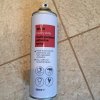Paul Henley
Club Member
Hi All bit of an update as its been awhile. Not a lot of progress if I'm honest. After getting the engine running and the car movable, I contacted the body shop to inform them the car was now ready for final panel fit and top paint coat. Before it left I marked up the car (using blue tape) to identify all the damage/scratches that I'd done while carrying out the "first fix".The amount of tape I used confirmed that for me personally it was the correct thing to do in carrying out the paintwork in 2 stages, and leaving the final panel fit and paint until after I'd completed the bulk of the mechanical restoration. Despite having a double garage it's surprising how little room you have while working around all the junk that a family accumulates in a garage. The car left on 10th March and I was hopeful I'd have it returned in 4 weeks, not a chance, the car has been away for about 3 months now and I'd say is probably about 75% complete. The first thing they do is trial fit all the panels to the car to ensure proper alignment prior to painting and this required a lot more preparation than I'd anticipated. Very few of the panels to be fitted were original to the car, the doors and tailgate were sourced from the states, the front wings were new from Nissan, the headlight pods were new from the states though I'm unsure if they were OEM, The bonnet was second hand from within the UK. This mixture of new/second hand panels has required a lot of rework to ensure the correct fit and the lines of the car proper. As is often stated, the bulk of the work in bodywork is the preparation not the actual painting. I dropped by today to check on progress and was pleased to find the majority of the panels have now been painted in either primer or final coat prior to fitting and hopefully it won't be to long before its return, though I didn't press for a date. I did bring home a spare air filter box that I'd asked them to paint in the original orange (as well as the original now fitted to the engine) and I was very happy with the match. A few pics attached, hopefully it won't be to long before I'll have one of all the paint finished...
Paul
Paul




























































